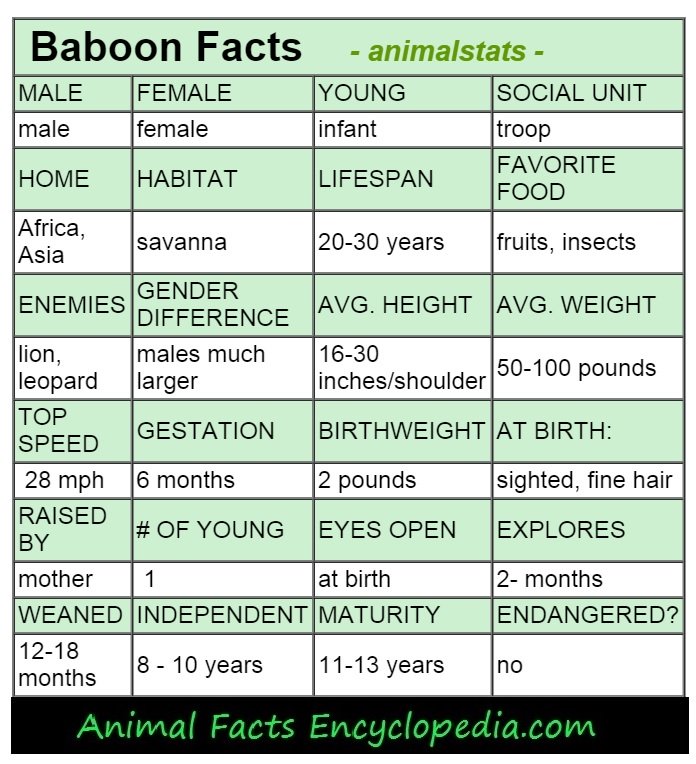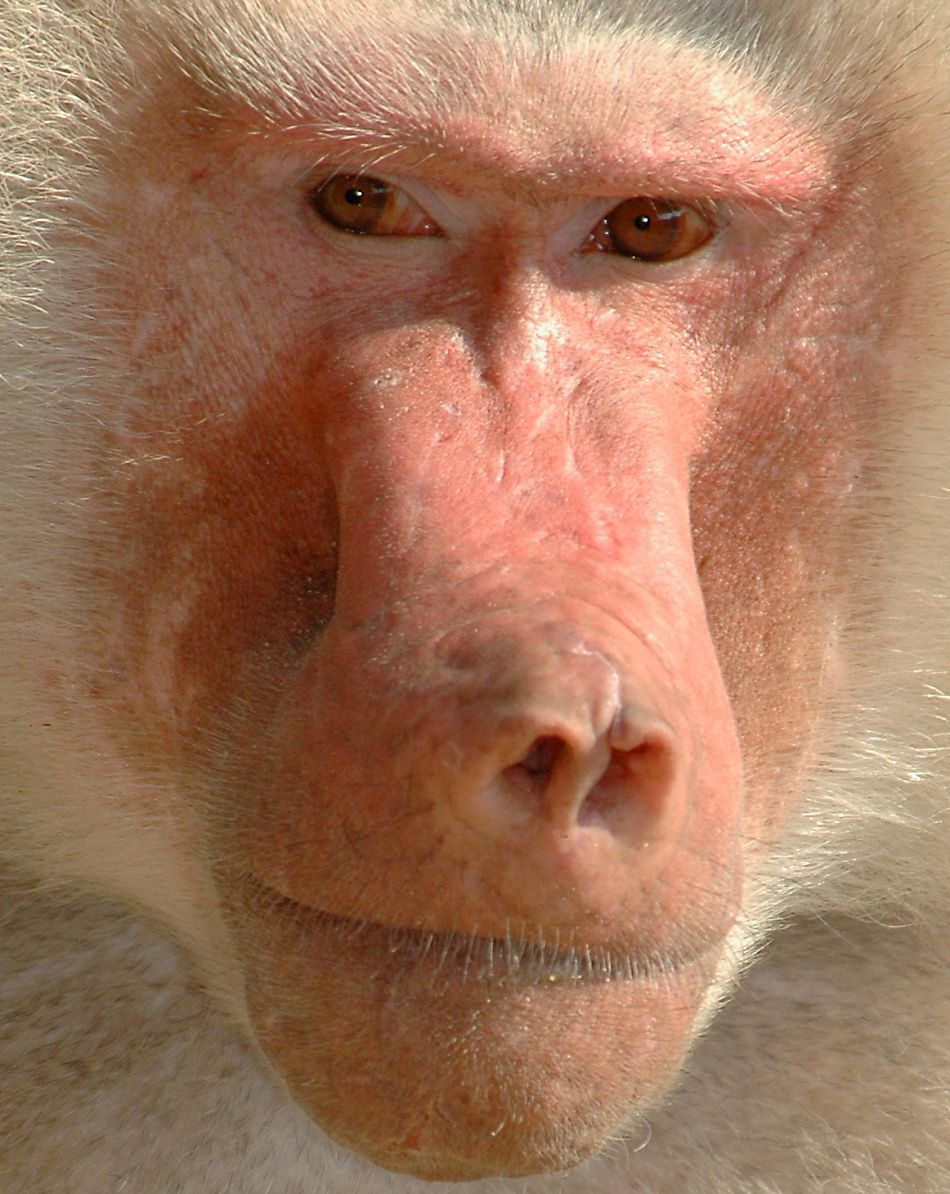baboon Facts
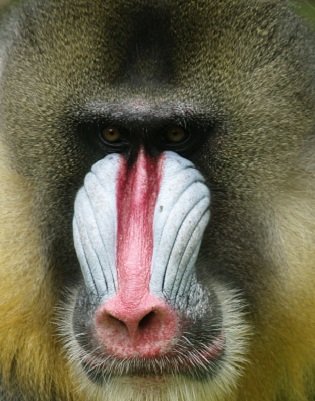 Portrait of a Mandrill
Portrait of a MandrillThere are five species of old world monkeys known as baboons. The olive, yellow, chacma, hamadryas and guinea baboons of the genus papio. The mandrill, which is the monkey with the colorful face, was once classified in the same genus as the baboons, but was moved to its own in 1970.
Another large terrestrial monkey often referred to as a baboon is the gelada, a dramatic looking animal with bare red flesh over its heart. Although the mandrill and gelada are not technically baboons, they are very closely related and have very similar lifestyles, and so are often included in discussions of baboons.
Baboons are very distinctive looking monkeys inhabiting much of Africa and some areas of Asia. They have long, almost dog-like snouts, very close-set eyes, and their arms and legs are almost the same length, so they walk very much like a dog.
Sometimes referred to as "dog monkeys" baboons are very common in the African landscape. They are very social animals that live in large, lively groups called "troops" of up to 100 members.
Baboons spend the majority of the day walking on all fours on the ground. They retire to the trees at night, and are very good climbers, but like all Old World monkeys their tail is not prehensile and cannot assist in climbing other than with balance.
The mandrill is the largest monkey species and has just a stump of a tail.
Grooming, feeding together, and general socializing are key to the well being of the baboon troop. Baboons are very vocal and communicate not only with about 40 different distinct vocalizations but with numerous hand and arm gestures and very expressive faces.
They have very mobile lips, cheeks and brows, and have distinct expressions for submission, begging and initiating play. Baboons make allot of eye contact with each other and are very affectionate, holding hands, hugging, and of course, mutually grooming.

Baboons are one of the few animals other than humans that have been seen "staring into each others eyes".
The large troop splits into smaller units for foraging during the day, and and is made up of closely related females and their young, with unrelated males trying to gain favor or dominance over females.
Baboon society is generally rather peaceful and cooperative with multiple adults assisting in the rearing of youngsters and troops actively involved in the defense of all members. Some species, the chacma and hamadryas in particular, and some individual troops prove to be much more violent, however, and fighting among males to gain dominance may also include infanticide.
There is extreme size difference between the sexes with adult males usually at least twice as large as adult females. The hamadryas baboon male develops an amazing white mane as it matures, and of course, the mature male mandrill has a colorful snout of red, white and blue, with a ruff of golden fur under his chin and similar colors on his rump. In fact, the male mandrill is probably the most colorful mammal in the animal kingdom. - Baboon Facts
Baboon lifestyle
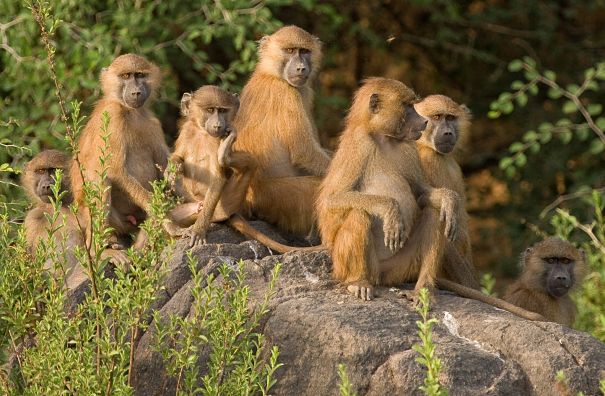 troop of yellow baboons
troop of yellow baboons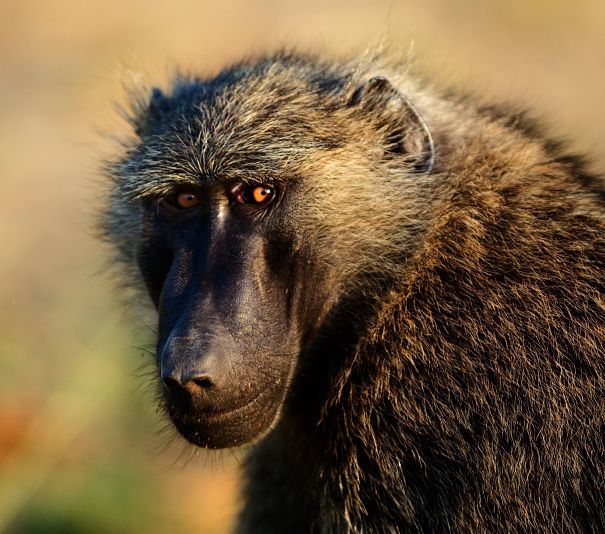 olive baboon closeup
olive baboon closeupTroops of loud and energetic olive and yellow baboons are an iconic sight on the African savanna. These baboons are the most common of the baboon species and some of the largest monkey species overall.
They are extremely similar and there is some question as to whether they should be considered separate species. The yellow baboon is lighter in color, slightly smaller and has a different home range than the olive. Both have almost identical lifestyles . Neither of these species are currently endangered, but as human beings encroach upon more of their territory conflicts are more common.
Today, human beings are the number one predator of baboons. Baboons have been known to raid crops, and even break into barns and outbuildings. They will kill and eat farm fowl and small animals such as goats and rabbits as well.
Farmers defend their crops by hunting down baboons and troops that have raided barns or buildings have been hunted down by entire towns of people.
The very smart and resourceful baboon has put itself in harms way through its own nerve and cleverness. Another potential threat to these animals is an increase in their use in research laboratories. Recent international agreements have slowed and stopped much of the use of chimpanzees in research facilities, but the baboon and other primate species remain unprotected and are being used to fill a void.
The baboon is a remarkably bright creature that not only has a very complex social life, but is also similar to our ancestors in its ability to adapt to life outside of heavy forest.
The olive and yellow baboons willingness to forage for a large variety of foods from roots to insects, to, on rare occasions, small prey like birds and fawns, and its cooperative, relatively peaceful society find it living in the open savanna where few other primates have ever flourished.
Out on the savanna the olive and yellow baboons regularly encounter some of the largest predators in the world. Lions, leopards, African wild dogs and hyenas have all hunted baboons, and the baboon troop keeps a wary eye out for all these animals.
In general, baboons are very quick, and tend to avoid capture by some of these larger beasts, and baboons have been known to torment large predators, particularly old male lions, when they are sure the odds are in their favor.
In addition to interactions with unfriendly neighbors, baboons have been observed interacting playfully with mongooses and chimpanzees. These species have overlapping ranges where forests meet the open plains.
Chimps and baboons will occasionally wrestle and tickle-fight with eachother and both species make sounds of laughter when engaging eachother
On the darker side, chimpanzees have been known to actively hunt baboons, and the much larger, more intelligent chimps have a huge advantage when they choose to use it. - Baboon Facts
 It Is Baboooon!!
It Is Baboooon!!baboon reproduction
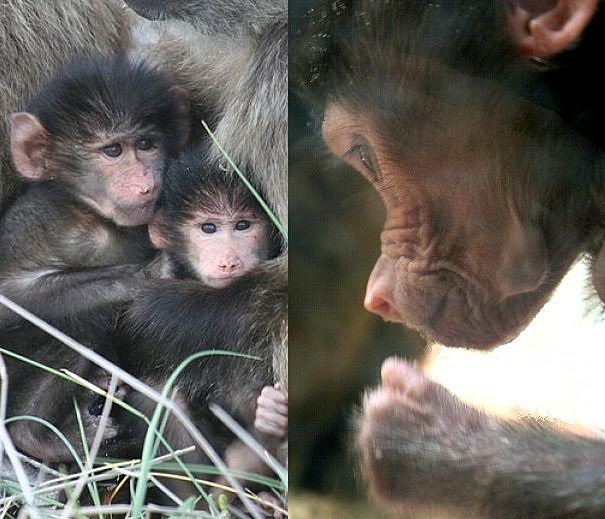 baby baboons
baby baboons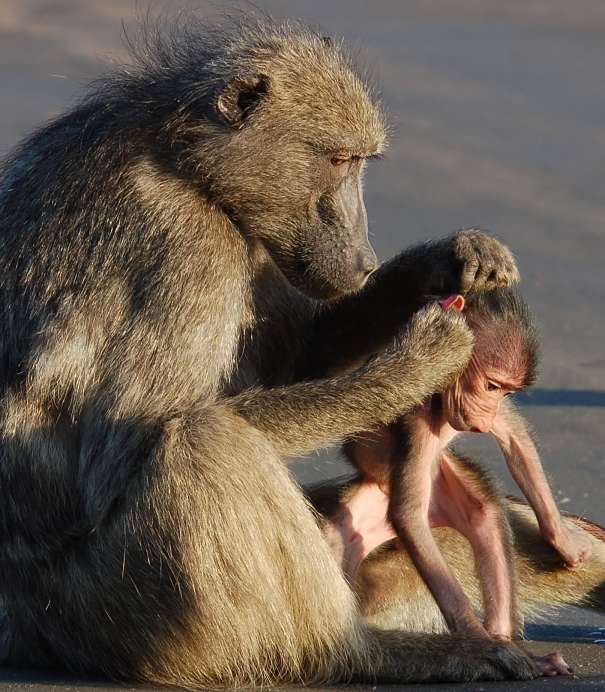 baboon mother and infant
baboon mother and infantThe female baboon comes into season about every 37 days and this is marked by pronounced sexual swelling. The genitals engorge and are bright pink in color indicating her condition. Her entire rump swells during this time and males show great interest.
Baboons are promiscuous and both males and females have multiple partners. Sometimes males will be possessive of certain females and fights may break out, but it is not only the most aggressive or dominant males that have a chance to mate.
Males will form friendships with females where they will escort, groom, share food and even help in the rearing of youngsters in order to gain favor with a female. Sometimes this works, sometimes she goes off with another more attractive suitor. Friendships between unrelated males and females may be lifelong, whether or not they involve sexual activity.
Females show their interest in a male by presenting their rump. The female will be pregnant for 6 months and give birth to one, very rarely two youngsters. The baby is helpless, but eyes are open and the infant is well furred.
The newborn baboon also has the typical young primates ingrained gripping reflex, and is able to hold itself against its mothers belly with tightly grasping hands and feet almost immediately after birth. Infants ride against the mothers stomach for the first several weeks, and then begin to ride on her back, usually in an upright position like a little jockey.
As youngsters begin to explore, they spend lots of time with their peers in active and exciting playgroups overlooked by several moms. Mothers are cooperative in the rearing of young and are protective of their friends youngsters.
Mothers can also be seen giving little lessons to groups of youngsters, and sharing food with multiple kids in the neighborhood. Males can be helpful with child rearing as well, and will also actively defend any youngster from predators.
The baboon society is matrilineal in form, with mothers, daughters and grandmothers staying together for their lifetimes. The social rank of the mother is usually passed along to the daughter. Young females stay with their troop for life, young males usually move on to another troop where they earn their way in by winning favor with females and older males by submissive grooming and friendship behaviors, or in some species, with active fighting to gain rank.
This period in a young males life is called "dispersal" and usually occurs sometime around the 7th or 8th year. Males will occasionally live in several different troops over their lifetime.
The hamadryas baboons are the exception to this lifestyle, having a different type of society with smaller groups of either one dominant male with a harem, or bachelor males. There is some agression between males and females among the hamadryas baboons, and lots of conflict between competing males.
In all baboon societies, as with many primates, there is a degree of infanticide that takes place, when male dominance roles are being disputed. - Baboon Facts

special choppers and special cheeks
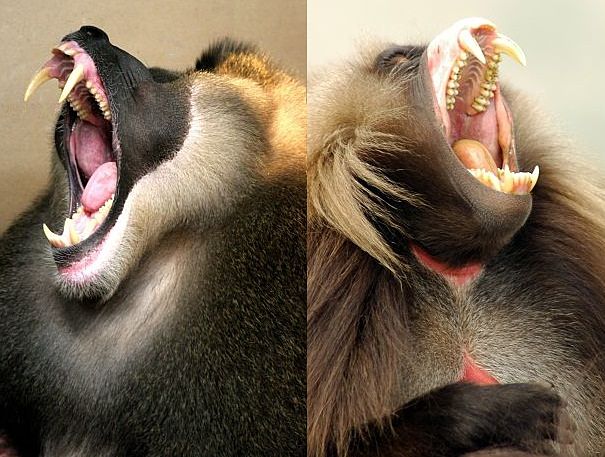 "roaring" baboons
"roaring" baboonsThe mandrill, the gelada, and the baboons all have several specialized physical features in common. Mature males develop massive canines that they use more often as a threat than anything else.
They usually display these fangs with a big slow-motion mock yawn - like a huge, silent roar.
Inside those big mouths is another interesting specialty. Baboons have cheek pouches similar to hamsters where they may smuggle some foodstuffs they don t have time to eat right away. When they are ready for a snack they push against the cheek from the outside and pull out some fruit or nuts that they can then commence eating.
why do baboon have red butts?
Speaking of cheeks, the "cheeks" on the rear of the baboon are also specialized.
Because baboons sit square on their rumps instead of squatting like some other monkey species, their butts are covered with hairless pads of calloused skin called "ischial callouses". This skin has no nerve endings and provides a permanent cushion for the baboon. There is also a bit of a ridge on the pads which allows for a secure seat on a thin branch. Baboons often sleep in an upright seated position on a tree branch, and this calloused area is believed to protect them and keep them secure in the trees.
Both sexes in all baboon species have these calloused areas, and the pads will vary in color. The males of some species have red butts occasionally too, in times of heightened aggression or during mating.
So, with a large area of skin being hairless for the purpose of comfortable seating, the exposed skin has evolved over time to become an indicator of sorts as well. When female baboons come into season, their entire genital region, including the rump cushion, engorges and turns red. This alerts males to her fertility. Once she is impregnated, the redness subsides, and when she has a lactating youngster it is at its least red, because she will not generally be ovulating again until the baby is weaned.
In a fascinating twist, it has been observed that some females with infants may actually falsely become reddened when a new male has taken over the troop. Since he is intent on mating with all females in the troop, the new male often kills any infants in order for the mother to come back into season and be willing to mate with him.
Researchers have recently observed females with infants becoming red and swollen immediately after the new male gains control of the troop. She will mate with the male at this time, but is not actually ovulating, and will not become pregnant from these matings, however her swelling, redness, and willingness to mate may keep the new male from harming her infant. - amazing!
 assorted wonderful baboons!
assorted wonderful baboons!a few more baboon facts
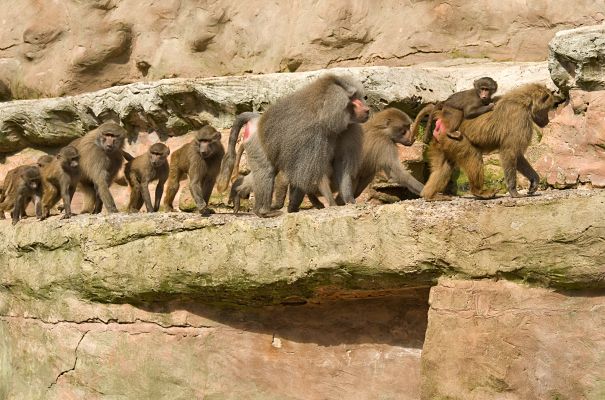 baboons on the move
baboons on the move- Baboons have cheek pouches like hamsters
- The mandrill is the largest monkey species
- Baboons spend most of their time on the ground - not in trees
- Baboons threaten each other with slow-motion "yawns" displaying their canine teeth
- Baboons walk on all-fours like a dog
- Baboons have lighter coloered skin on their eyelids and they will flash their lids to communicate.
- Male baboons are usually twice as large as female baboons - sometimes even larger
- Baboons do not use tools, but have been known to throw rocks, hit things with sticks, and wash some food items - Baboon Facts!
Scientific Classification:
| Baboon Facts - animalstats - | |||
|---|---|---|---|
| MALE | FEMALE | YOUNG | SOCIAL UNIT |
| male | female | infant | troop |
| HOME | HABITAT | LIFESPAN | FAVORITE FOOD |
| Africa, Asia | savanna | 20-30 years | fruits, insects |
| ENEMIES | GENDER DIFFERENCE | AVG. HEIGHT | AVG. WEIGHT |
| lion, leopard | males
much larger |
16-30 inches/shoulder | 50-100 pounds |
| TOP SPEED | GESTATION | BIRTHWEIGHT | AT BIRTH: |
| 28 mph | 6 months | 2 pounds | sighted, fine hair |
| RAISED BY | # OF YOUNG | EYES OPEN | EXPLORES |
| mother | 1 | at birth | 2- months |
| WEANED | INDEPENDENT | MATURITY | ENDANGERED? |
| 12-18 months | 8 - 10 years | 11-13 years | no |
see more animal extreme closeups
Recent Articles
-
African Animals - Animal Facts Encyclopedia
Oct 11, 16 10:27 PM
African Animals facts photos and videos..Africa is a wonderland for animal lovers, and a schoolroom for anyone who wants to learn about nature, beauty and the rhythm of life -
Baboon Facts - Animal Facts Encyclopedia
Oct 11, 16 10:26 PM
Baboon facts, photos, videos and information - Baboons are very distinctive looking monkeys with long, dog-like snouts and close set eyes. -
Great Apes Facts - Animal Facts Encyclopedia
Oct 11, 16 10:25 PM
Great apes facts, photos and videos..Human beings did not evolve from chimpanzees, modern chimps and gorillas do not appear in the fossil records until much more recently than homo sapiens..
